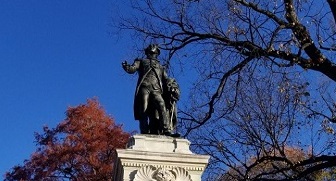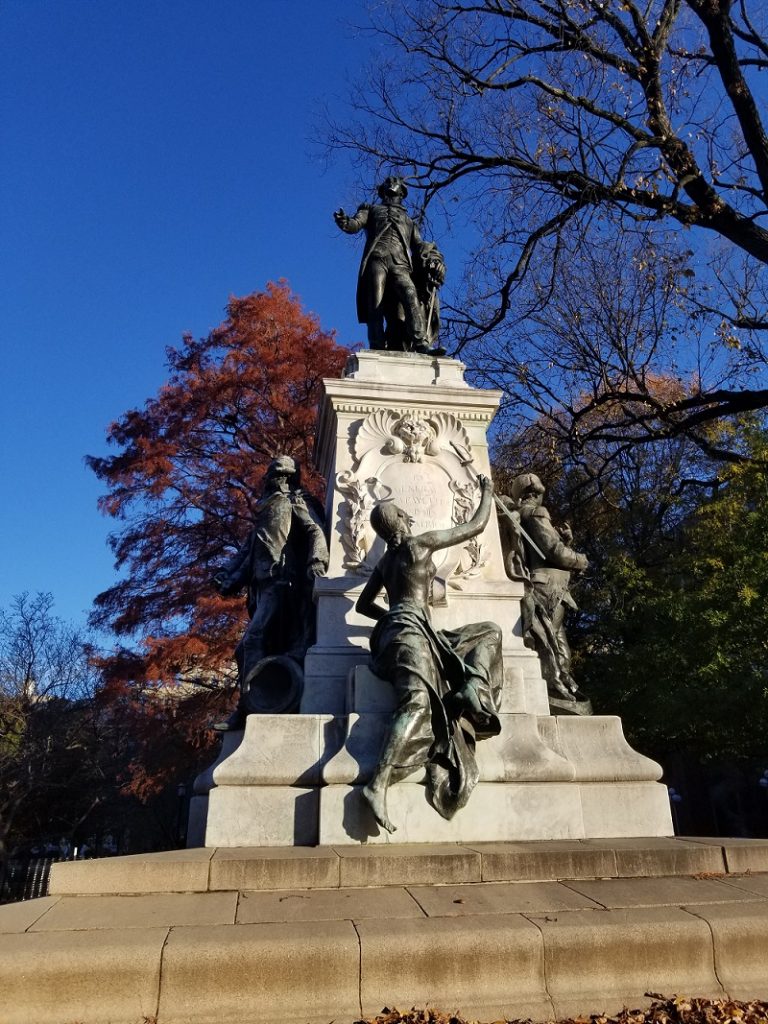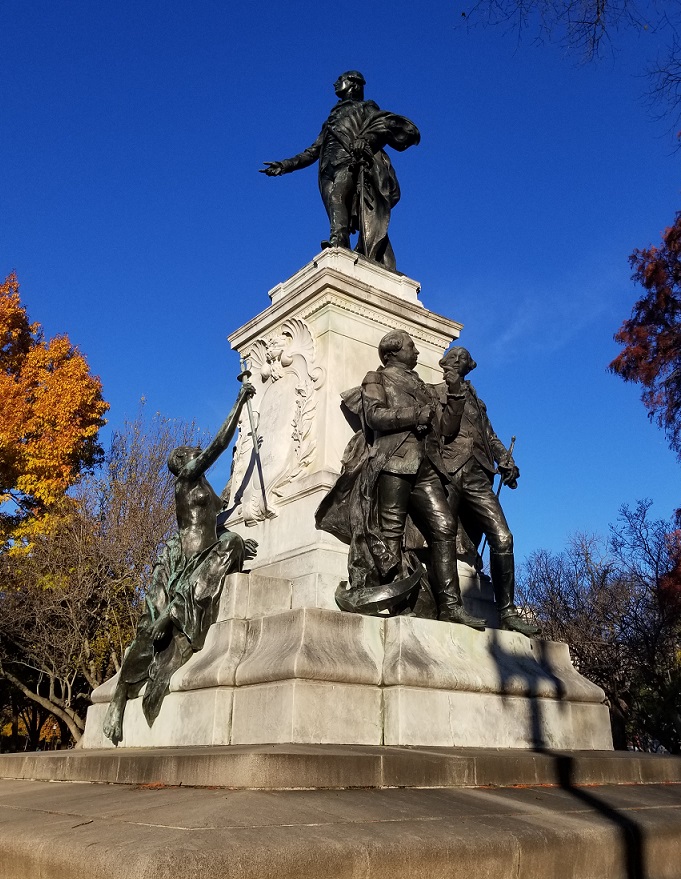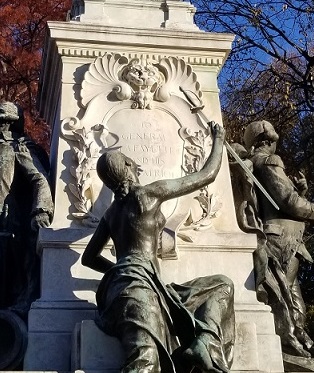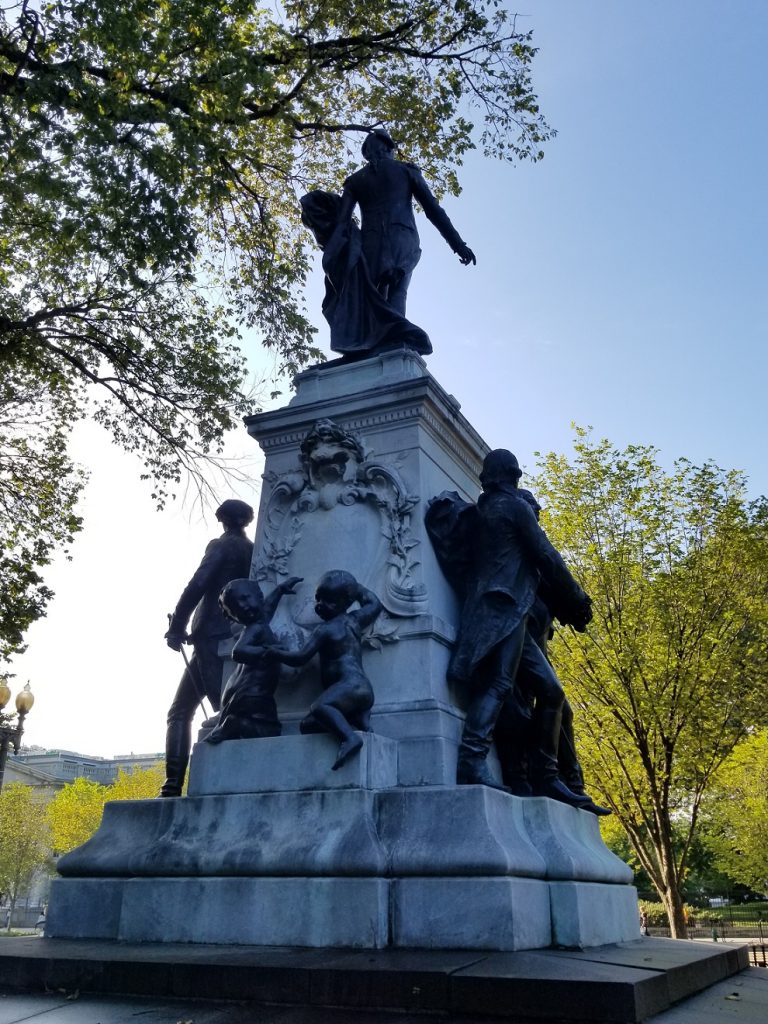Statue: General Lafayette
Location: Southeast corner of Lafayette Square
Sculptors: Alexandre Falgulere and Antoni Mercie, French
Cost to taxpayers: between $55,000 – $60,000
Lafayette Park was first referred to by that name beginning in the 1820s. By the time Clark Mill’s Andrew Jackson statue was placed in the center of the park in 1853, directly to the north of the White House, the park was officially listed as Lafayette Square.
Lafayette Park and Name
The first newspaper reference of the park’s name was in the November 21, 1934 edition of the Alexandria Gazette, which referred to the park, “On the north of the President’s house, the ground now called Lafayette square, has been well graded and planted with trees.” But the park had been referred to as Lafayette Square since the 50th anniversary celebration of the end of the American Revolution in 1824.
The area north of the White House was part of the President’s House park land, but was bare ground with a race track on its western edge, and remained that way until the rebuilding of the President’s House after it burned in 1814 during the War of 1812. The park boundaries were defined and trees were planted in 1924.
That year, Lafayette returned to America and made a grand tour. He traveled throughout America during 1824 and 1825 and visited all 24 states at that time. It was during this time of renewed pride in America and with a sense of historic fervor, that Congress first suggested memorializing General Lafayette.
Surrounding the park are buildings that date from the 19th and early 20th centuries. St. John’s Church was designed by Benjamin Latrobe in 1816 and is the oldest building on the square. In 1818, Benjamin Latrobe also designed and built Stephan Decatur’s house at the corner of 17th and H Streets, NW, the first private building on the square.
General Lafayette
Lafayette, whose title was the Marquis de Lafayette, and whose birth name was Marie-Joseph Paul Yves Roch Gilbert du Motier de Lafayette (1757-1834), was born in France in 1757 to a family with great wealth. Lafayette believed in the cause of the American Revolution (1765 – 1783). Lafayette was appointed by Congress to be a major general in the Army on July 31, 1777. He fought in the Battle of Brandywine in September 1777 where he was injured and in 1878 in the Battle of Rhode Island. In 1781, he and the forces under his command in Virginia blocked Cornwallis’ forces, which set up the Surrender of Yorktown.
Lafayette honorably retired from the Army on November 3, 1783. He returned to France and, in May 1779, France’s Louis XVI appointed him colonel commanding the regiment of the King’s Dragoons. Lafayette remained a lifelong friend of George Washington, and was a member of the Order of the Cincinnati. He died at his home in Paris on May 20, 1834, at the age of 77.
The Lafayette Memorial
Fifty years after Lafayette’s death, in 1884, the U.S. Congress passed a bill appropriating $50,000 for the purpose of erecting a statue to the memory of Gen. Lafayette. The bill also created a memorial commission.
In 1888, the statue to Lafayette was finished: constructed by French artists Alexandre Falgulere and Antoni Mercie.
However, the memorial commission could not decide on where to place the statue. The obvious place for the statue, Lafayette Park, already had a statue. The statue to President Andrew Jackson was considered by many as one of the finest pieces of American-made statuary, and had been located in the center of park since 1853.
Discussions on where to place the statue continued for several years. And as of September 9, 1890, the Evening Star reported that “all idea of placing the statue in Lafayette Park as a side attraction to the Jackson statue has been definitely abandoned.” The Commission at that time was set on the reservation at 15th and Pennsylvania Avenues NW just south of the Treasury Building. But by November 1890 it was decided that the memorial to Lafayette would be placed in the southeast corner of the the square, and eventually the other corners would be used for three more new statues.
The memorial was finally placed in Lafayette Square on February 20, 1891. The day earlier the Lafayette statue had been hauled out of the Congressional stables where it had been stored since arriving in Washington, D.C., from France a year earlier. There was no dedication ceremony.
On March 30, 1892, Senator Hiscock and Representative Little of New York introduced a petition from Lafayette Post No. 14 G.A.R., of New York and signed by 81 members of the post. The petition recites the fact that the Lafayette monument erected in Washington has never been dedicated, which is an exceptional case in the history of all the monuments or statues erected to the memory of the United States military and naval forces, and says that the appropriate time and occasion for the proper unveiling and acceptance of the statue in the formal manner would be during the coming national encampment of the Grand Army of the Republic to be held in Washington, D.C., September 19, 1892.
Lafayette Statue Design
The memorial to Lafayette is actually a memorial to Lafayette and his Compatriots. The pedestal is Italian marble and the figures are bronze.
The statue to Lafayette shows him standing in a commanding attitude wearing an Army uniform. His left hand is resting on the hilt of his sword and is partially covered with his military cloak; his long sword rests on the ground. His right hand is outstretched and clenches his hat. The statue is about 10 and a half feet in height.
In front of the memorial is a female figure, America or Victory, looking up and offering a sword. Above the figure is a large bronze tablet surrounded by laurel leaves, surmounted by a gargoyle and inscribed with “Lafayette et ses compagnons” — “To Lafayette and his compatriots”
At the rear of the pedestal are two small allegorical figures and an area for a short inscription.
On the east side or left side is a group representing the French naval heroes who assisted in the Revolution. One of the statues is that of Vice Admiral Count Charles Hector Theodat D’Estaing, who brought over the first fleet of French war vessels sent to assist the patriots and who was wounded while leading an the attack on Savannah, then held by the British. D’Estaing is dressed in the French naval costume, and an anchor lies at his feet. His right hand rests on his sword and his left is raised, he looks engaged in conversation with his companion.
Across from D’Estaing is Lieut. General Francois Joseph Paul, Counte de Grasse, who came over in 1781 with twenty-six ships and 250 merchantmen. He assisted in the capture of Cornwallis at Yorktown and received the thanks of Congress for his services. General Washington had a great regard for him, and when he was leaving for the West Indies presented him with two horses as a token of especial esteem. He is represented as listening to the remarks D’Estaing. He, too, is in French uniform and a star glitters on his breast.
On the west or left side are represented Rochambeau and Chevalier Duportaille.
Jean Baptiste Donatieu de Vineur, Comte de Rochambeau, commanded the French forces sent to America. He assisted Lafayette in the Virginia campaign and provided valuable services in the seige of Yorktown. Rochambeau is portrayed in French uniform, and stands next to Duportaille.
Chevalier Louis Lebeque Duportaille was one of four French officers engaged by Benjamin Franklin to serve in the American Army. He had charge of the engineering operations at Yorktown, and was one of the general officers particularly mentioned by Washington in his dispatches. He is represented as a young man, dressed in the Continental uniform. At his feet lies a mortar.
In the rear, or on the north side of the monument, are two little cherubs holding up a large bronze shield, enclosed in scrolls and vinery, with the following inscription:
Erected
By the Congress of the U.S.
To
Gen. Lafayette
And
His Compatriots
In commemoration of the services rendered by
them during its struggle for
Independence
References
The Lafayette Statue Bill Passed. The Evening Star. December 18, 1884.
The Lafayette Statue. The Evening Star. April 14, 1888.
A Splendid Memorial: The Magnificent Monument to Lafayette and His Countrymen. The Washington Post. August 17, 1890: p9.
Looking for its Home: The Lafayette Monument to Remain in Boxes for Awhile. The Washington Post, August 30, 1890, p8.
Down Went the Trees: They had to Fall to Make Room for the Lafayette Statue. The Washington Post, November 23, 1890, p3.
The Lafayette Statue, The Washington Post, February 19, 1891
